Evaluating the impact of telemedicine mobile units on health outcomes, healthcare system resilience, and disaster response in flood-affected areas: a case study of Sehat Kahan
DOI:
https://doi.org/10.18041/2665-427X/ijeph.1.11568Keywords:
Telemedicine services, disaster relief,, mobile unit, developing nations, resource analysis, flood emergenciesAbstract
Introduction: The study explores the deployment of telemedicine services. Sehat Kahani introduced a two-tier telehealth model combining physical camps, mobile units, and a telehealth app to enhance healthcare accessibility and delivery in crisis.
Objective: To assess the effectiveness of Sehat Kahani's telemedicine model in improving healthcare outcomes and system resilience. It also aims to identify key factors contributing to the successful integration of telehealth during flood emergencies.
Methods: Semi-structured interviews were conducted with key stakeholders: Sehat Kahani staff, healthcare providers, beneficiaries, funders, and top-level management. Interviews provided insights into the implementation process, challenges encountered, and strategies to address these challenges. We identified themes related to resource analysis, accessibility, security, scalability, training, evaluation, collaboration, and sustainability.
Results: The findings underscore the significance of comprehensive assessments, budget analysis, and collaboration with government agencies and corporate partners in successfully implementing telehealth services. Accessibility was effectively addressed through Sehat Kahani's multi-tiered model, which combined mobile clinics with a user-friendly telehealth app. Security, privacy, and confidentiality were maintained by adhering to data protection regulations (HIPAA). Training programs for healthcare professionals focused on empathy, rapport building, and technical proficiency. Sehat Kahani's scalability measures and preparedness for increased patient volume facilitated efficient service delivery during disasters.
Conclusions: Sehat Kahani's comprehensive approach, encompassing resource analysis, accessibility, security, scalability, training, evaluation, collaboration, and sustainability, successfully integrates telehealth into disaster relief efforts. This model offers valuable insights for future telehealth initiatives in disaster response scenarios, particularly in developing nations affected by flood emergencies.
Downloads
References
Reinhardt JD, Li J, Gosney J, et al. Disability and health-related rehabilitation in international disaster relief. Glob Health Action. 2011;4:7191. doi:10.3402/gha.v4i0.7191
Alajmi D, Almansour S, Househ MS. Recommendations for implementing telemedicine in the developing world. Stud Health Technol Inform. 2013;190:118-120.
Rao B, Lombardi A 2nd. Telemedicine: current status in developed and developing countries. J Drugs Dermatol. 2009;8(4):371-375.
Subbarao I, Bostick NA, James JJ. Applying yesterday's lessons to today's crisis: improving the utilization of recovery services following catastrophic flooding. Disaster Med Public Health Prep. 2008;2(3):132-133. doi:10.1097/DMP.0b013e3181842504
Calleja P, Wilkes S, Spencer M, Woodbridge S. Telehealth use in rural and remote health practitioner education: an integrative review. Rural Remote Health. 2022;22(1):6467. doi:10.22605/RRH6467

Published
Issue
Section
License
Copyright (c) 2024 Interdisciplinary Journal of Epidemiology and Public Health

This work is licensed under a Creative Commons Attribution-NonCommercial-NoDerivatives 4.0 International License.

